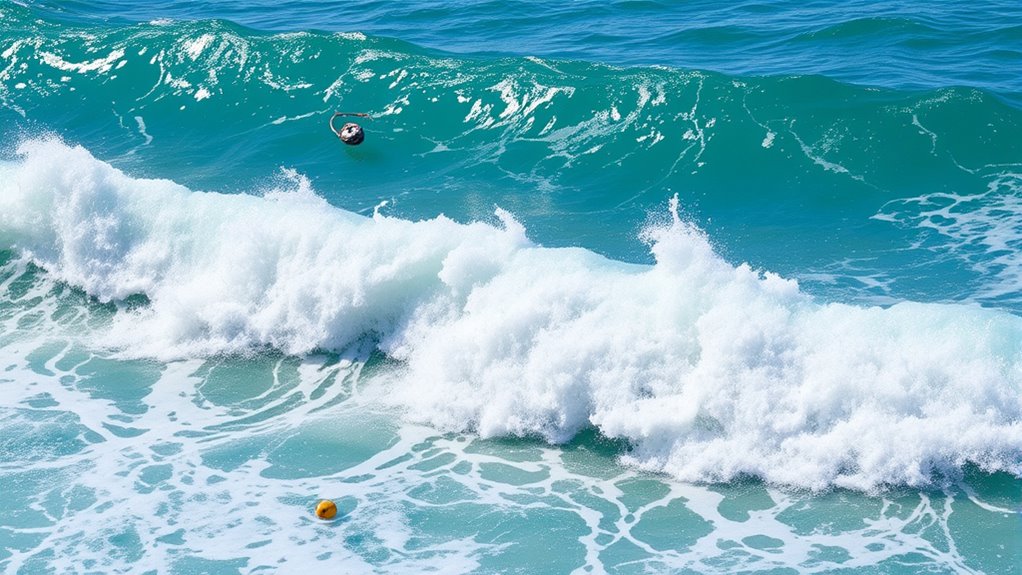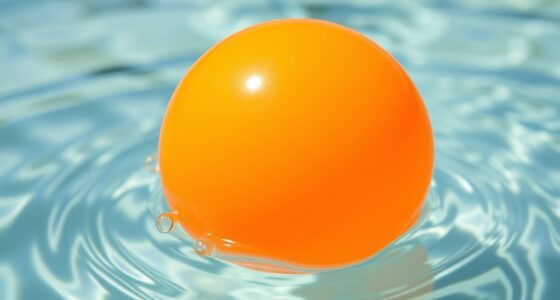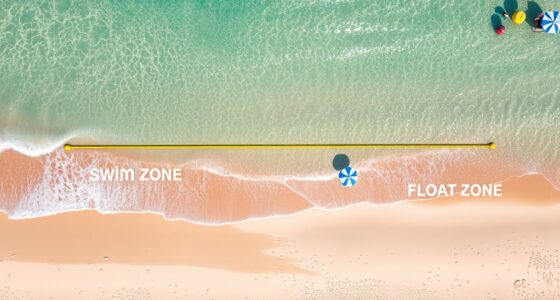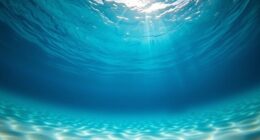Waves travel across water by transferring energy, causing the surface to oscillate without moving the water permanently. When you see floating objects, they respond to this energy with movements like bobbing or swaying, which depend on wave size and force. Interference patterns can make water calmer or more turbulent, affecting how objects react. If you’re curious about how these patterns shape the ocean’s surface and object behavior, keep exploring these fascinating wave dynamics.
Key Takeaways
- Waves carry energy across water’s surface without permanently displacing water molecules.
- They cause floating objects to oscillate or sway through energy transfer.
- Wave interference patterns can amplify or calm water movement, affecting object behavior.
- Larger, energetic waves produce more noticeable movement in floating items.
- The behavior of objects depends on wave energy, interference, and changing wave patterns.
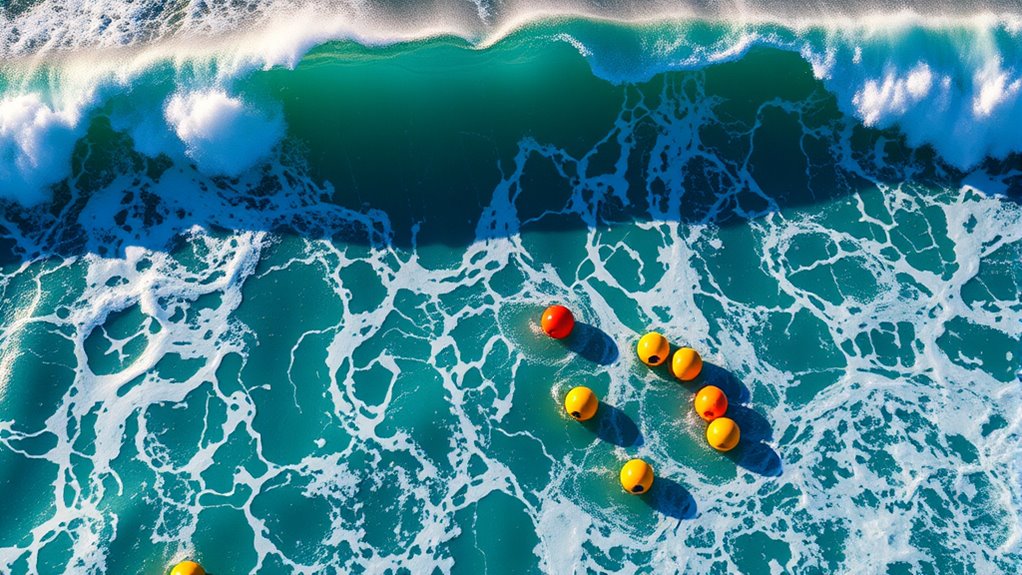
Have you ever wondered how waves affect floating objects? When you observe a boat bobbing on the water or a leaf drifting in the pond, you’re witnessing the fascinating dance of energy transfer through waves. Waves are energy carriers that move across the water’s surface, transferring energy without permanently displacing the water itself. As a wave travels, it pushes and pulls on floating objects nearby, causing them to move in response to the wave’s energy. This movement isn’t random; it’s a direct result of how waves transfer energy from one point to another. When a wave reaches a floating object, the energy from the wave causes the object to oscillate up and down or sway side to side, depending on the wave’s motion. This is why you see floating debris or vessels move as waves pass underneath.
Wave interference plays a pivotal role in how waves behave as they travel and interact with floating objects. When two waves meet, they can reinforce each other or cancel out, resulting in wave interference. If the crests of two waves align, they combine to create a larger, more powerful wave—this is called constructive interference. Conversely, if a crest meets a trough, they cancel each other out through destructive interference, leading to calmer water patches. These interactions can influence how waves affect floating objects, sometimes amplifying their movement or temporarily stabilizing them. You might notice that during certain conditions, floating objects seem to bounce more vigorously or suddenly settle, which often results from wave interference patterns that alter the energy distribution in the water.
Wave interference can cause floating objects to bounce or settle unexpectedly.
Understanding the process of energy transfer helps you grasp why waves can exert force on floating objects without sinking them. The energy carried by wave motion moves through the water, causing oscillations at the surface. When this energy reaches something floating, it imparts force, causing the object to follow the wave’s oscillations. The size and strength of this movement depend on the wave’s energy, which can be influenced by factors such as wind speed, duration, and fetch—the distance over which the wind blows across the water. Larger, more energetic waves transfer more energy, resulting in more noticeable movement of floating items.
Wave interference further complicates this picture, as it can produce a variety of wave patterns, from calm patches to turbulent areas. These patterns directly impact how floating objects respond at any given moment. Sometimes, the waves’ energy is concentrated in a particular spot, making objects bounce intensely, while in other areas, interference creates calmer conditions. Recognizing these effects helps you understand why floating objects behave unpredictably, sometimes gently rocking and other times violently shifting, all driven by the complex interplay of energy transfer and wave interference.
Frequently Asked Questions
How Do Different Types of Waves Vary in Their Effects on Floating Objects?
Different types of waves impact floating objects differently through wave energy and buoyant forces. For example, larger, more powerful waves transfer more energy, causing floating objects to move vigorously or even capsize. Smaller waves exert less force, gently rocking or barely affecting the objects. The way waves travel influences these effects; faster or longer waves can generate greater buoyant forces, making objects respond more dramatically to their movement.
Can Waves Cause Permanent Changes to the Shape of Floating Materials?
Waves can cause permanent changes to floating materials through wave erosion and sediment displacement. When waves repeatedly hit objects, they wear down surfaces, leading to shape alterations over time. Sediment displacement can shift or expose parts of floating materials, causing lasting damage or reshaping. You’ll notice that continuous wave action gradually transforms the appearance and structure of floating objects, making these changes permanent with enough exposure.
How Do Underwater Currents Influence the Movement of Surface Waves?
You notice that underwater currents shape surface waves through the coincidence of underwater topography and wave energy. As currents interact with features like seafloor contours, they redirect and modify wave paths, influencing their speed and height. This alignment creates a deeper connection between ocean layers, revealing how underwater landscapes guide surface activity. Your awareness of these dynamic interactions underscores how unseen currents and topography work together to influence what you see on the surface.
What Role Does Wave Frequency Play in the Impact on Floating Items?
Wave frequency impacts floating items by affecting the wave energy they experience. Higher frequency waves have more energy and cause rapid, smaller movements, which can make floating objects bob intensely. Lower frequency waves carry less energy but produce larger, slower motions. You’ll notice that as wave frequency increases, the impact on your floating items becomes more vigorous, influencing stability and movement depending on the wave’s energy and frequency impact.
Are Certain Floating Objects More Resistant to Wave-Induced Motion?
Yes, certain floating objects are more resistant to wave-induced motion. You’ll find that buoyancy effects play a big role; objects with greater buoyancy stay steadier because they displace more water, providing stability. Additionally, material durability matters—items made from sturdy, flexible materials can better withstand continuous wave action without breaking or deforming. So, choosing buoyant, durable materials helps floating objects resist the disruptive effects of waves and stay more stable.
Conclusion
Remember, just like waves shape the shore, waves influence everything on and around them. They can carry you gently or toss you around, depending on their strength. By understanding how waves travel and affect floating objects, you gain a better appreciation for nature’s power. Keep in mind the saying, “Smooth seas never made a skilled sailor.” Embracing the challenges waves bring helps you learn and grow, both on the water and in life.

